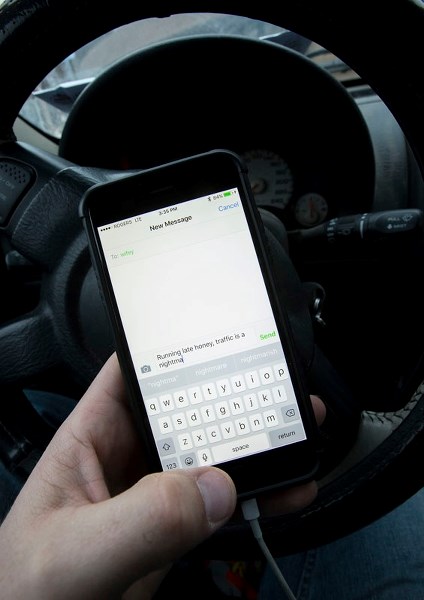While police officers in Alberta are always on the lookout for distracted drivers, they're putting extra emphasis on enforcement this month.
While police officers in Alberta are always on the lookout for distracted drivers, they're putting extra emphasis on enforcement this month.
February is marked as Distracted Driving Month for local law-enforcement agencies and for Alberta Transportation, and patrols have been ramped up in an effort to enhance education and enforcement for this still-prevalent problem.
Cpl. Timothy Gaultois, with the St. Albert Traffic Services Unit, said drivers exhibit many problems out on the road, but distracted driving is among the most prevalent because it's done by choice rather than being the result of poor driving habits.
“Cell phones, there's not a day that goes by where you see guys talking and driving, or texting on their cell phone,” he said. “You see some people who will hold their cell phone out in front of them, thinking this is not talking on the cell phone.”
He said any use of a cell phone, whether talking or texting, and even if it's just for a second or two, is distracted driving and could result in a ticket.
On top of a $287 fine, provincial legislation that came into effect Jan. 1 this year means drivers convicted of distracted driving will now get three demerit points as well.
Although it's too soon to say if this increased penalty will result in increased compliance, but Gaultois said anecdotally, when he issues tickets people now know they're going to get demerits.
“They're concerned about the points, but not concerned enough they're not going to use their phones,” he said.
Most of the drivers police pull over, for whatever reason, tend to have their cell phones either in their laps, or on the seat next to them – and while driving they still see drivers with their phones to their ears nearly every day.
“That's where the issues happen. They're rear-ending people, they're cutting people off, you come to an intersection and the light turns green but they're just sitting there texting away,” Gaultois said. “There's definitely some issues with cell phones.”
Bruce Adams, a Regional Traffic Safety Consultant with Alberta Transportation, said while other forms of distracted driving are problematic, cell-phone use is by far the most prevalent among the 87,000 distracted driving convictions entered between when the provincial law came into effect in September 2011 and March 2015.
“Of those convictions, 97 per cent of them were for using a cell phone – texting or speaking on one,” he said.
Furthermore, he said research shows distracted driving is a factor in about a quarter of all collisions. While it would be difficult to draw a causal link between cell phone use and collisions, there's certainly a correlation there.
Adams said despite the best efforts of law-enforcement agencies and Alberta Transportation, reducing distracted driving can only really be achieved when drivers begin to change their own attitudes. It was the same thing with seat-belt legislation when it first came into effect in Alberta, which now has better than 95-per-cent compliance.
“When we started, compliance was not as good with it,” he said. “It just takes time.”
Meanwhile, police continue to enforce the law and try to educate drivers until they get the message.
